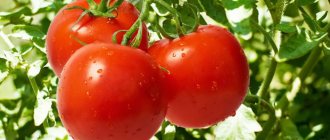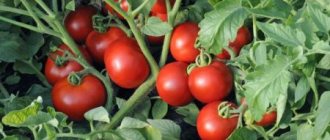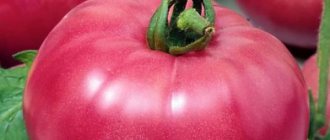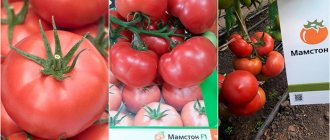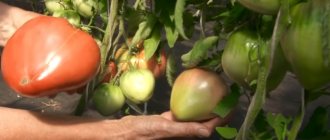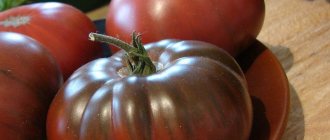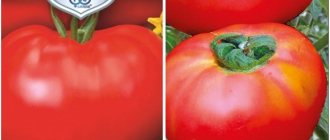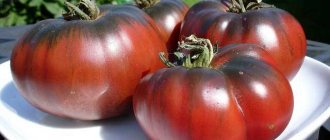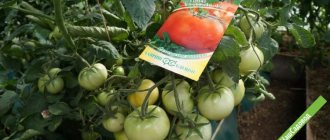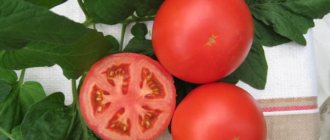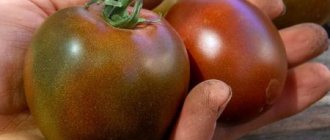Home page » Vegetable growing » Assortment of vegetables
The far north was created for extreme farming regions. Tomatoes have time to fill and ripen on the bushes in the short and cool summer. The variety does not shine with yield, but it requires minimal care.
- Description of the variety
Video: tomato harvesting in the Far North in Yakutia
- Video: standard tomatoes in open ground
Description and characteristics of the variety
The tomato was created by specialists together with employees of the St. Petersburg Union of Seed Producers. One of the distributors is. It was included in the State Register in 2007 and is recommended for cultivation throughout Russia. The cultivar shows excellent results in open ground even in Siberia.
The bush is determinate, low, up to 65 cm, although the originator states that the plant is even smaller - 25-30 cm. It is standard, strong, densely leafy. The leaves are medium. Fruit clusters are small, up to 6 fruits. The harvest ripens approximately 95 days after germination and ends by mid-August.
Tomatoes are medium or small, 100-70 g each. Their shape is oval, the color is red. There are 4-6 seed chambers inside. The taste is classic, sweet and sour.
The shape and size of the fruits differ depending on the location on the bush - the former have noticeable ribbing and size up to 100 g, and the latter (upper) are smooth and smaller.
Growing seedlings from seeds
In order to grow strong, healthy and abundantly fruiting bushes, you need high-quality seedlings. It can be grown independently or purchased from trusted sellers. Sowing time depends on the growing region. They start from the period when spring frosts end. When growing seedlings from seeds, certain rules are followed. The process takes place in several stages.
Seed preparation
Before sowing, the seeds are prepared and hardened. They are placed in a bag and heated in hot water (45 °C) or on a radiator for 3 hours.
Then the bag with the contents is placed in a solution of potassium permanganate for 25-30 minutes (1 g of the substance is dissolved in 100 ml of water). After soaking, the seeds are washed well and left for 24 hours:
- in a solution of boric acid (0.5 g per 1 liter of water);
- or a solution of wood ash (2 tablespoons of ash and 1 liter of water);
- or use a solution of ash and mullein (you will need 1/2 teaspoon of each component, which is added to 1 liter of water).
Next, the seeds are germinated. Fill them halfway with warm water and wait for them to hatch. The water is changed 3 times a day.
The hatched seeds are hardened in the refrigerator on the middle shelves for 19 hours, then they are kept at room temperature for 5 hours. This alternation of heat and cold is carried out for 6 days, making sure that the seed material is always moist. Seeds prepared in this way are sown as seedlings or in open ground.
Soil preparation
For seedlings, prepare a loose, permeable soil mixture of turf soil, humus and sand, taken in a ratio of 2:2:1. It is moistened 6-7 days before sowing.
On the day of sowing, soil is poured into the container in a layer of 5-7 cm, leveled and lightly compacted. Then pour over a hot solution of copper sulfate (1 tsp per 10 liters of water).
Read about disinfecting the soil before planting seedlings here.
Contents and location
To grow seedlings, use plastic cups, special cassettes, boxes, containers and similar suitable containers. I fill it with soil mixture. Place the containers on a windowsill on the south side or in a warm room where the optimal temperature is ensured.
When sowing, the temperature should be maintained at +20-25 °C.
A week after the emergence of seedlings, the seedlings are hardened, the temperature is reduced during the day to +12...+15 °C and +6 °C at night. In such conditions, the future seedlings are kept for about 5-7 days, until the first true leaf appears. After this, it is returned to a comfortable temperature.
Planting seeds
Seeds are sown for seedlings in early to mid-April in prepared soil. They do this as follows:
- Containers with crops are placed in a warm place. It is not necessary to cover them with film or glass to speed up the emergence of seedlings. With regular watering, high-quality seeds germinate quickly and do not linger in the ground.
- Seeds are sown in moist soil.
- Make grooves, leaving a distance of 5-7 cm between them.
- Water them from a teapot and place the seeds at a distance of 1.5-2 cm.
- After sowing, sprinkle them lightly with soil on top. The seed sowing depth is 1-2 cm.
A good option for planting seeds would be to use peat tablets. They are pre-soaked, and the soil mixture is poured into plastic cups and spilled with warm water. The seeds are placed on the surface of the tablets; for better germination, the Zircon stimulator is dripped onto them with a pipette (2 drops of the product per 100 ml of water, consumption - 1 drop per 1 seed). The seeds are sprinkled with a small amount of substrate on top.
Seedling care
Containers with seedlings are left in a bright place where the air temperature does not fall below 16 °C. Picking is carried out when 2 true leaves appear on the plants and the stems become stronger. They are planted in separate pots, the diameter of which is at least 10 cm. The picked seedlings are shaded for 2-3 days, that is, they are transferred to the shade so that the sun's rays do not fall on them.
In the first week after picking, the seedlings are kept at a temperature of 20-22 °C in clear weather; on a cloudy day, 15-16 °C of heat is enough for them. As soon as 4-5 true leaves appear on the plant, the temperature is reduced to 18 °C during the day and 14–15 °C at night. On cloudy days the temperature may be 2-3 °C lower.
Seedlings are watered moderately on sunny days in the early morning. Excess moisture in the soil and high air humidity lead to rapid growth of plants and their fragility, which can lead to stem breakage during transplantation. On the other hand, lack of soil moisture negatively affects tomato yields. A week before planting young plants in a permanent place, watering is reduced.
Transplanting seedlings into the ground
Seedlings are planted in a permanent location in May-early June:
- The air should warm up during the day to +14…+15 °C, and the soil to +10…+12 °C.
- Small holes are dug in the garden bed, the distance between which is 30-40 cm.
- The holes are watered with a weak solution of potassium permanganate.
- The seedlings are buried 2 cm to the cotyledon leaves.
- Strongly elongated seedlings are planted at an angle, covering the stem to 1/4 or 1/3 of the height.
Some vegetable growers advise feeding tomatoes with yeast fertilizer. It is made a day before planting from 10 g of fresh yeast and 10 liters of water. 220 ml of “yeast” water is poured into the hole, and then the plants take their place.
After planting, the soil at the roots is pressed tightly, there should be no mound left at the stem, and watered abundantly with water.
Feeding seedlings is also necessary. The first feeding is carried out 8-12 days after picking, using mineral fertilizers. You can buy them ready-made in a store or make the mixture yourself.
Dissolve in 10 liters of water:
- 5 g ammonium nitrate;
- 15 g potassium chloride;
- 40 g superphosphate.
If necessary, fertilizing is repeated 10 days after the first.
10 days before transplanting seedlings into open ground, they are hardened off, gradually lowering day and night temperatures. For 3-4 days, the plants are taken out into fresh air at night.
Landing
Seeds are disinfected with potassium permanganate or Fitosporin and sown for seedlings in a special substrate. You can buy it in a store or make it from peat with humus, but agroperlite is more useful for plants. The mixture is prepared as follows:
- 5 parts of soil from the garden;
- 1 part vermiculite;
- 1 part agroperlite.
Then the substrate is spilled with a fungicide solution and the seeds are sown 2 months before planting the seedlings in the ground.
The crops are germinated in a warm place, then kept under cool conditions. Provide good lighting. Seedlings are fed once and treated with Fitosporin to prevent diseases. They dive after the development of 2 leaves.
You can plant bushes in the garden according to a pattern of 40 by 60 cm or compact them, placing up to 8 pieces per 1 square meter. m.
Tomatoes Far North on video
You can see other interesting varieties of tomatoes in our Tomato Catalog with photos, descriptions and reviews. Enjoy watching.
If you grew tomatoes in the Far North, please write whether you liked them or not. What was the yield and taste of the fruits like under your climatic conditions? How do you rate the disease resistance of this variety? Briefly describe the advantages and disadvantages of this tomato in your opinion. If possible, attach a photo of your tomatoes to your comment. Thank you!
Your reviews of the Far North tomato and additions to the description will help many gardeners evaluate this variety more objectively and decide whether it is worth planting or not.
Growing and care
During the first week, water the bushes once every two days, then as needed. Be sure to heat the water and try not to soak the stems and leaves. The soil is mulched.
Feed for the first time after planting on the 7-10th day, then at intervals of 2-3 weeks. Plants need complex mineral fertilizers containing nitrogen, potassium and phosphorus. Young bushes can be fed with organic matter, such as manure, but it contains mainly nitrogen, and the abundance of such fertilizing leads to an overdose and reduced yield.
Selection of seedlings
Of course, it is best to grow tomatoes yourself from start to finish. However, if it is not possible to plant and germinate seedlings, then they will have to be purchased on the market.
In this case, it will not be superfluous to know how to choose the right quality seedlings. The choice should be based on the external qualities of the sprouts.
So, the seedlings should be:
- 45-60 days old;
- height no more than 30 cm;
- with 6-8 true leaves that have a beautiful green color and healthy appearance;
- with an intact, well-developed root system;
- stem diameter 5-7 mm;
- without formed fruits.
When choosing, you should carefully inspect the areas under the leaves for the presence of harmful insects.
It is worth abandoning plants that:
- deep green leaves curled downwards are a sign that the sprouts have been fed with nitrogen;
- leaves are deformed, wrinkled, curled - evidence of diseased plants.
It is advisable to purchase seedlings from trusted sellers whom you trust. Otherwise, you should collect as much information as possible about it from the implementer. Seedlings can be sold both in containers and with an open root system. The first has a higher survival rate and higher cost.
Did you know? The Guinness Book of Records, among other records, also collects agricultural achievements. One of the record holders is a tomato, which was given the nickname Big Zach. The 3.8-kilogram giant fruit was raised by American Dan McCoy.
Soil and fertilizers
An important condition for successfully growing tomatoes is soil preparation. Moreover, it is essential both for seedlings and for adult plants planted in the main place of growth.
For seedlings, you will need loose, light soil that has good air and moisture conductivity.
The composition may be as follows:
- turf or garden soil (1 part);
- peat (2 parts);
- river sand (0.5 parts);
- humus (2 parts) or compost (1 part);
- wood ash (1 cup per bucket) or dolomite flour (3-4 tablespoons per bucket of mixture).
To achieve good breathability, you can add a little sphagnum moss.
Important! Before planting seedlings, the soil should be disinfected by calcining it in the oven or steaming it in a double boiler. In the beds, sandy loam soil with an acidity level not exceeding 6.5 pH is desirable.
It is better if cabbage or cucumbers were previously placed on it. It is not recommended to plant tomatoes in one place for two years in a row, or after peppers, eggplants, or potatoes.
In the beds, sandy loam soil with an acidity level not exceeding 6.5 pH is desirable. It is better if cabbage or cucumbers were previously placed on it. It is not recommended to plant tomatoes in one place for two years in a row, or after peppers, eggplants, or potatoes.
Soil preparation should begin in the fall - you will need to dig it up and add organic matter: humus or compost. In the spring, immediately before planting seedlings, mineral fertilizers need to be applied to the ground. This can be potassium chloride or superphosphate.
